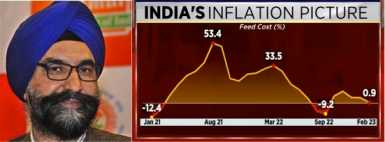While cereals inflation of 12 to 13 percent has caught headlines, the second largest factor pushing up food inflation is milk prices. In February Consumer Price Index (CPI) data showed milk prices up by 9.6 percent from year-ago levels; higher than an already elevated 8.8 percent year-on-year rise in January. And while cereal prices will hopefully ease as the rabi harvest comes in; milk prices are seen getting higher. Experts say the rise in milk prices is because fodder prices were very high last winter.
In fact, in 2022 — from January to June — feed cost was up 30 percent on average because of the high cost of maize and soy cake. Karnataka Milk Marketing Federation has kept milk prices unchanged at Rs 50 a packet, but they sell 900 ml instead of 1,000 ml in one packet. So shrinkflation over there. Tamil Nadu state government-owned milk supplier Aavin could procure only 27 lakh litres in March versus the 37 lakh litres per day that it did in previous months, The Indian Express reported. And finally, the Bombay Milk Producers Association as of March 1 increased buffalo milk prices from Rs 80 to Rs 85 per litre — that is a stiff increase.

In an interview with CNBC-TV18, RS Sodhi, former MD of Gujarat Cooperative Milk Marketing Federation (its flagship brand is Amul) and currently the President of the Indian Dairy Association said that he does not foresee any reduction in milk prices until Diwali, which is typically celebrated in October or November. He explained that it is only around this time that we may see price stability in the market.
He said, “Unfortunately, this winter, we do not have the commodity stocks. So, this summer will be very difficult to meet the requirements. But after Diwali; the flush season starts when production increases then I can expect that prices will stabilize or may go down. Therefore, until Diwali, I do not foresee any reduction in milk or milk product prices.”
When asked about the reason for the recent increase in milk prices, Sodhi cited fodder inflation as the main factor. He explained that there is a lag of four to five months between feed cost inflation and milk inflation. This means that any changes in the cost of producing milk will not be immediately reflected in the price paid by consumers.

Additionally, Sodhi’s comments suggest that consumers may need to brace themselves for continued high prices for several more months. However, with a little patience and understanding, we can weather this period of instability and look forward to more predictable prices in the future.
Source : CNBC TV 18 March 21 2023

